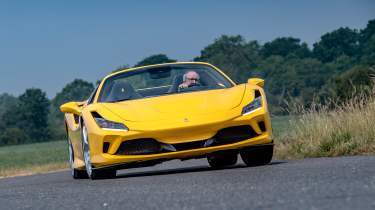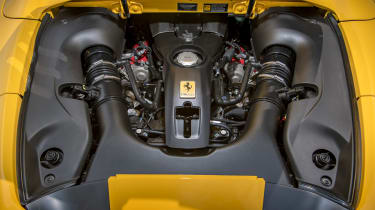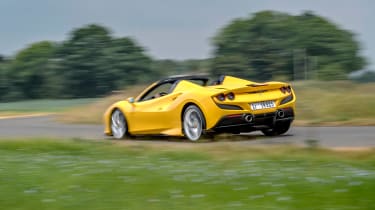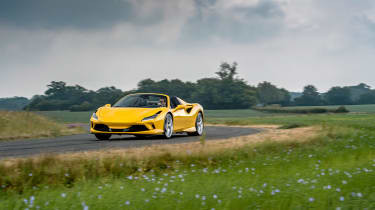Ferrari F8 Spider (2019 – 2023) review – Maranello’s answer to the McLaren 720S Spider
The Ferrari F8 Spider was the last of its kind to wear that badge and use V8 power alone, with its 296 successor going V6 hybrid, with a GTS badge
The Ferrari F8 Spider was the last roofless, all-motor mid-engined V8 Ferrari. It took over from the 488 Spider and 458 Spider before it as Ferrari’s mid-engined pop-top. At the time, it faced down competition from McLaren’s 720S Spider and Lamborghini’s sonorous Huracán Spider.
The F8 Spider would also be the last (for now) to wear the Spider name, its 296 successor adopting the GTS moniker that used to be the preserve of alfresco Ferraris that had removable solid roof panels, rather than fabric folding tonneaus. Spiders continued everywhere else in Ferrari’s lineup, however, from the SF90 Spider and Roma Spider, to today’s 12 Cilindri Spider.
Engine, gearbox and technical highlights
Ferrari’s award-winning 3.9-litre twin-turbocharged V8 made its final appearance in a mid-engined supercar, without electrical augmentation, in the F8 and F8 Spider. It obviously lived on in the Roma and SF90 but the 296 GTB and GTS that replaced the F8 and F8 Spider, moved to an all-new V6.
The V8 packed a specification that’s fairly close to that of its fitment in the 488 Pista track special, with titanium con rods, a lighter crankshaft, a lightweight flywheel, as well as higher-lift cams and shorter inlet tracts. The exhaust system was however revised, to offset the addition of emissions-reducing gasoline particulate filters. The gearbox was Ferrari’s familiar but fabulous seven-speed dual-clutch. The key figures are 710bhp at 8000rpm and 568lb ft from 3250rpm.
More reviews
Essentially under the skin the Spider carried across everything that made the Tributo the car it was, from Side Slip Control 6.1, to the traction-maximising Adaptive Performance Launch function, and styling that differs slightly but purposefully from the old 488’s.
The key difference to the coupe is, of course, the two-part folding roof, which does its dance in 14 seconds and at speeds of up to 28mph. The rear deck is naturally reprofiled thanks to this addition up top. Visually, the Spider works better with the roof down than with it up, but in the interests of thorough journalism, we can report that aerodynamically the cabin will remain mostly dry at motorway speeds in heavy rain. (OK, we got caught roof-down in a rainstorm. Only the tops of the seats got a little damp…)
Performance and 0-62 time
Performance wasn’t been compromised a jot. In an F8 Spider, you’ll still pass 62mph from rest in 2.9sec, and go on to 211mph given a quiet and legal enough stretch of road.
Driving the F8 Spider isn’t so much a series of actions as a broad spectrum of experiences, from the infrared warmth of cruising along, roof down, in a car that’s admirably liveable for a car with such potential, to the ultraviolet intensity of deploying anything close to its accelerative and cornering potential.
Accessing the engine’s potential is like turning a rheostat. Give the throttle a purposeful squeeze with the tachometer at anything above 2000rpm or so and the F8 is drawn towards the horizon like there’s some unstoppable force pulling it along on a rope. If you’re going merely quickly, traction is never an issue either, particularly in the default ‘Sport’ manettino setting, so you can get on the power with some intent out of corners without fear of the car biting back.
And at the ultraviolet end? Ultra-violent, more like. The F8’s pace is pretty shocking when you find a stretch long and clear enough to unleash it, and the rest of the car steps up its game to meet that remarkable engine.
The engine still lacks the aural character of the old naturally aspirated units – it’s crisp and mechanical, but not musical – but so brutal is the acceleration you’ll probably be overwhelmed by sensations other than sound unless you’re on a circuit anyway.
The new part is clearly the two-part folding roof, which does its dance in 14 seconds and at speeds of up to 28mph, while the rear deck is naturally reprofiled thanks to this addition up top. Visually the Spider works better with the roof down than with it up, but in the interests of thorough journalism we can report that aerodynamically the cabin will remain mostly dry at motorway speeds in heavy rain. (OK, we got caught roof-down in a rainstorm. Only the tops of the seats got a little damp…)
Ride and handling
The F8 Spider really does feel quite friendly when you’re ambling about. You’re only ever a toe flex from getting a taste of that engine, but save for steering, whose speed needs some adjusting to at first, the Spider slurs smoothly through its gearchanges, is largely untroubled by patchy road surfaces (particularly if you select the ‘Bumpy Road’ damper setting) and is even relatively quiet, roof up or down.
The high-geared steering rack is so responsive that there’s a Caterham-like economy of movement to any cornering input, and there’s never any doubt the front tyres will struggle to bite – just point and it follows.
Gearshifts are lightning fast, the brakes scrub speed powerfully and precisely, and the chassis is so grippy and responsive that the car behaves like it’s half the weight. You start to feel both ends of the car moving around more but always within a broad window of control, provided you’re not taking the mickey with the laws of physics.
Driving at no more than half the car’s potential, you’ll already be quicker than virtually everything else on the road. The F8’s skill, perhaps particularly in Spider form with the extra sensations of having the roof dropped, is that it still makes you part of the action even if you’re nowhere near its limits. At similar pace, a McLaren is probably still more tactile, but the scalpel-like precision of the F8 has its own appeal.
It’s fast, intense, and really demands a circuit to fully exploit, but the F8 Spider, like its fixed-roof counterpart, is unquestionably a great supercar.
Ferrari F8 Tributo values, rivals and successor
The £225,897 starting price of the F8 Spider when new was a fair chunk more than the coupe, so you had to be dedicated to the cause of open-top motoring. For reference, the F8 Tributo was £203,476, and in turn each was around £20k more than the old 488 and its equivalent Spider. Again, only starting prices. Today, F8 values are very among the most recent of Ferrari’s production mid-engined supercars – you could have a used 296 GTS for the same money as some higher spec Spiders. The oldest with the most mileage (only 16,000) can be had for a little over £200k.
The F8’s natural rival was the McLaren 720S, which had a similar power output and was similarly remarkable to drive, albeit with a very different look and feel, compared to the Italian. Choosing between the pair is a close-run thing indeed – the 720S is a previous eCoty winner, don’t forget, so it’s by no means clear-cut. The other option is of course the Lamborghini Huracán Spider, which while less of a touchey-feely driver’s car and less potent, did have the howl of a naturally-aspirated V10 on its side. A shame, that the Lambo’s driving position was almost intolerable, something the McLaren and Ferrari got exactly right.









